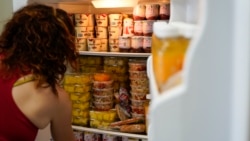Some Americans do not have enough food to eat.
They receive free food from aid organizations, or assistance from the government so they can buy food themselves. Many towns and cities have food pantries, centers where people can get free food.
However, hungry Americans who also have food allergies often find themselves with either limited or costly food choices.
Common allergies include foods that contain milk or eggs, some kinds of nuts, and flour made from some grains, such as wheat. People with celiac disease, for example, cannot digest gluten, a protein that comes from some grains. The protein causes inflammation that can damage their digestive system and make them sick.
A number of organizations in the U.S are working to solve this problem. It became more serious during the COVID-19 crisis as more Americans sought food assistance after losing their jobs.
Before the crisis, people with food allergies could visit food pantries and find substitutes for milk or grains that they were allergic to. But COVID-19 shut most food pantry buildings. Visitors could no longer enter and choose the foods they needed. Instead, pantry workers would fill individual boxes with food and give them to the needy as they arrived outside the pantry.
Carla Carter works for the National Celiac Association. She said the food pantry process turned into “here’s a box of food, good luck.”
Some government assistance programs permit people to choose their own foods at local stores. However, products for people with food allergies often cost two or three times more than usual foods. So, people with allergies get less food as a result.
There are not confirmed numbers on how many people in the U.S. who receive food aid also have allergies. But early estimates suggest it is likely to be millions.
Emily Brown of Kansas City, Missouri, has a daughter with food allergies.
Eight years ago, when her daughter was two, Brown said she had a sad experience at a food pantry. The organization could only offer potatoes and a spicy tomato sauce for her daughter. There was nothing else for the hungry child.
Brown said she thought: “I cannot be the only mother struggling with this.”
When she got to her car, she cried.
Now, she leads an aid group called the Food Equity Initiative. She works to help about 200 needy families who suffer food allergies. The program provides them with $150 per month so they can buy safe, healthy foods.
Brown is working with two allergy doctors at Northwestern University in Chicago to learn how many people who have food allergies also do not have enough food to eat.
She said the way the U.S. helps people who do not have enough food is “too general.”
Kate Scarlata is a dietician or food expert. She is working with food pantries. She says operators should start asking visitors simple questions like, “Are you on a special diet? Are there any foods that make you sick?”
Now that more people in the U.S. are vaccinated and public places are reopening, organizations hope that people who need food help will be able to choose what they eat.
That is how it works at a place in San Diego, California, called Porchlight Community Services. Claudia Montenegro runs Porchlight.
She said a group of people who give away their time and money help make Porchlight a place with good choices for people who cannot spend a lot of money on food.
Porchlight has things like yogurt made from coconut instead of milk, peanut-free butters, and gluten-free grain products.
Elizabeth Shoemaker gets food from Porchlight. She said the organization helps her get healthy food that will not make her sick. Instead of paying for the food, she spends some time each week working for Porchlight.
“I now know I can depend on them next week, so I don’t have to hoard food,” she said.
I’m Dan Friedell.
Kathleen Ronayne wrote this story for the Associated Press. Dan Friedell adapted it for Learning English. Caty Weaver was the editor.
Where do people who need help getting food go in your country? Tell us in the Comments Section and visit our Facebook page.
____________________________________________________________
Words in This Story
allergy –n. a medical condition that causes someone to become sick after eating, touching, or breathing something that is harmless to most people
inflammation –n. a condition in which a part of your body becomes red, swollen, and painful
digestive system- n. the parts of your body like the stomach and intestines the process food
sauce- n. a thick liquid that is eaten with or on food to add flavor to it
yogurt –n. a food that is made when bacteria are added to milk and that is often flavored and chilled
hoard –v. to collect and hide a large amount of (something valuable)












